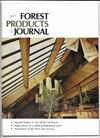从搭接剪切过渡到内粘接对胶合板测试的价值
IF 1.2
4区 农林科学
Q3 FORESTRY
引用次数: 0
摘要
搭接剪切试验多年来一直是胶合板粘结强度试验的标准。其目标是预测胶合板的长期耐久性。该测试也被工厂质量管理团队用于根本原因分析,以确定问题。该测试有几个问题,两个重要的问题是:(1)唯一测试的粘结是与被测试的贴面相邻的粘结;(2)测试对刻缝的准确性是高度主观的。本文将解决第一个问题,这是一个更大的问题。在面板的长期暴露过程中,粘合线最有可能失效的是暴露的表面,或者更有可能是最弱的粘合。搭接剪切试验不能同时测试所有粘结,因此无法确保在每个样品上测试最弱的粘结。本文中包含的数据清楚地表明,在标准搭接剪切试验中会遗漏的粘结线之间存在差异。最后,测试的主要债券位于面板的中心;因此,结果将是有偏见的,可能不是一个准确的代表小组将如何在该领域的表现。这些缺陷可以通过转换到其他木制品中常见的标准内部粘合测试来弥补。本文章由计算机程序翻译,如有差异,请以英文原文为准。
The Value of Transitioning from the Lap Shear to an Internal Bond for Testing Plywood
The lap shear test has been the standard for bond strength testing in plywood for years. Its goal is to predict the long-term durability of the plywood panels. This test has also been used for root cause analysis by mill quality management teams to identify issues. There are several problems with the test, two significant problems being, (1) the only bond tested is the one that is next to the veneer tested, and (2) the test is highly subjective to the accuracy of the kerfing. This paper will address the first problem, which is the larger issue. During the long-term exposure of the panel, the bond lines most likely to fail are the exposed surface or, more likely, the weakest bond. The lap shear test does not test all the bonds simultaneously, so there is no way to ensure the weakest bond is tested on each sample. The data included in this article clearly showed that there was a difference between the bond lines that would be missed in the standard lap shear test. Lastly, the main bonds tested are in the center of the panel; therefore, the result would be biased and may not be an accurate representation of how the panel would perform in the field. These deficiencies are remedied by shifting to the standard internal bond testing common in other wood products.
求助全文
通过发布文献求助,成功后即可免费获取论文全文。
去求助
来源期刊

Forest Products Journal
工程技术-材料科学:纸与木材
CiteScore
2.10
自引率
11.10%
发文量
30
审稿时长
6-12 weeks
期刊介绍:
Forest Products Journal (FPJ) is the source of information for industry leaders, researchers, teachers, students, and everyone interested in today''s forest products industry.
The Forest Products Journal is well respected for publishing high-quality peer-reviewed technical research findings at the applied or practical level that reflect the current state of wood science and technology. Articles suitable as Technical Notes are brief notes (generally 1,200 words or less) that describe new or improved equipment or techniques; report on findings produced as by-products of major studies; or outline progress to date on long-term projects.
 求助内容:
求助内容: 应助结果提醒方式:
应助结果提醒方式:


